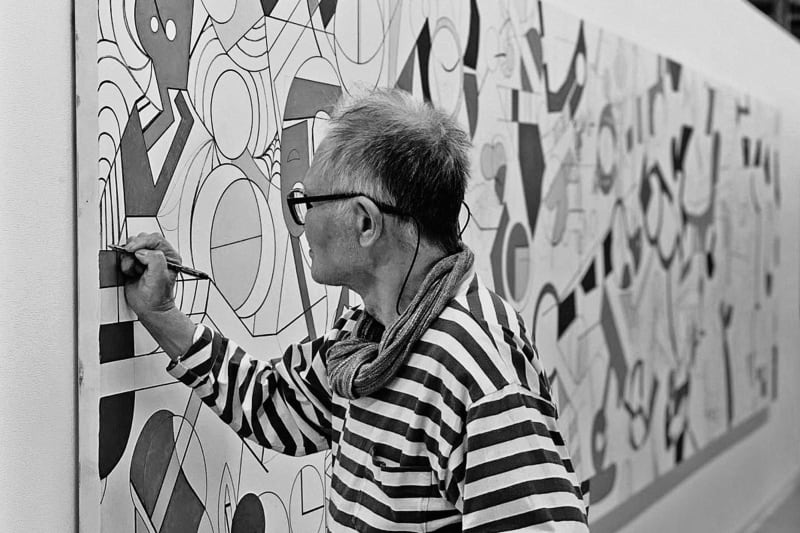Takeshi Kawashima American-Japanese, b. 1930
Takeshi Kawashima has created groundbreaking, culturally-invigorating paintings since the 1960s, blending his native Japanese culture with the onset of the Color Field, Minimalism, and Pop movements within the United States. Immigrating from Tokyo to New York in 1963, his practice reflects the divisive yet liberating components of assimilation, eradicating the basis of cultural barriers through a coherent visual language. Organized through a loose, grid-like structure, he adorns his paintings with a series of pictographs, contorting their usage as symbols when focalized individually. His stark aesthetic decisions, with the contrast of juxtaposing hues, invoke a decorative effect that is heavily inspired by the Japanese coat of arms. Kawashima’s large-scale works culminate as a reflection on the nature of semiotics, reducing the canvas to the symbolic convolution distilled in its surface.
Takeshi Kawashima (b. 1930, Takamastu, Kagawa) began his academic career by attending the School of Fine Art in Musashino, Tokyo in 1955. After graduating, he began teaching at the Yoyogi Art School until displaying his work at a series of exhibits across Tokyo. Kawashima has showcased in numerous solo and group exhibitions at Hannah-Kent Gallery in New York, NY, Walter Wickiser Gallery in New York, NY, Yamaso Art Gallery in Kyoto, Japan, Kagawa Prefectural Culture Museum in Takamatsu, Kagawa, Japan, and Mitchell Algus Gallery, in New York.
His works are in the permanent collections of numerous private and public institutions, including the Norton Simon Museum, Pasadena, CA; the Museum of Modern Art, New York, NY; and the National Museum of Modern Art, Tokyo, Japan. In addition, Kawashima is the recipient of several awards and grants, including the Daniel Schnakenberg Scholarship (1965) and the Silvermine Award (1967). He currently lives and works in Naoshima, Japan.
-
 S4-B, 1975Screenprint on paper7 1/2 x 7 1/2 in
S4-B, 1975Screenprint on paper7 1/2 x 7 1/2 in
19.1 x 19.1 cmNumber 1 of 35Signed, numbered, titled and dated to lower edge -
 Silver and Grey, c. 1970'sSerigraph28 x 20 in
Silver and Grey, c. 1970'sSerigraph28 x 20 in
71.1 x 50.8 cmNumber 4 of 30Signed, titled and numbered -
 No 102, c. 1970'sSerigraph20 1/2 x 20 1/2 in
No 102, c. 1970'sSerigraph20 1/2 x 20 1/2 in
52.1 x 52.1 cmNumber 19 of 20Signed, titled and numbered -
 Untitled , c. 1970Screenprint on paper10 x 10 in
Untitled , c. 1970Screenprint on paper10 x 10 in
25.4 x 25.4 cmNumber 74 of 95Signed and numbered -
 Untitled , c. 1970Screenprint on paper9 1/2 x 9 1/2 in
Untitled , c. 1970Screenprint on paper9 1/2 x 9 1/2 in
24.1 x 24.1 cmArtist proofSigned lower right edge -
 Silver and Grey , c. 1970Screenprint on paper13 1/2 x 10 in
Silver and Grey , c. 1970Screenprint on paper13 1/2 x 10 in
34.3 x 25.4 cmArtist proofSigned and titled -
 N.Y.S-8 Blue, 1969 - 1975Screenprint on paper13 1/2 x 12 1/2 in
N.Y.S-8 Blue, 1969 - 1975Screenprint on paper13 1/2 x 12 1/2 in
34.3 x 31.8 cmNumber 30 of 75Signed, titled and numbered -
 Untitled , 1969 - 1975Screenprint on paper11 1/2 x 11 1/2 in
Untitled , 1969 - 1975Screenprint on paper11 1/2 x 11 1/2 in
29.2 x 29.2 cmNumber 12 of 84Signed and numbered -
 Untitled , c. 1970Screenprint on paper17 1/4 x 17 in
Untitled , c. 1970Screenprint on paper17 1/4 x 17 in
43.8 x 43.2 cmNumber 54 of 60Signed and numbered -
 No. 69, c. 1970Screenprint on paper21 x 21 in
No. 69, c. 1970Screenprint on paper21 x 21 in
53.3 x 53.3 cmNumber 3 of 80Signed and numbered
-
 NY Series #212 , 1967Oil on canvas68 1/2 x 68 1/2 in
NY Series #212 , 1967Oil on canvas68 1/2 x 68 1/2 in
174 x 174 cmSigned Kawashima, titled and dated (verso)













